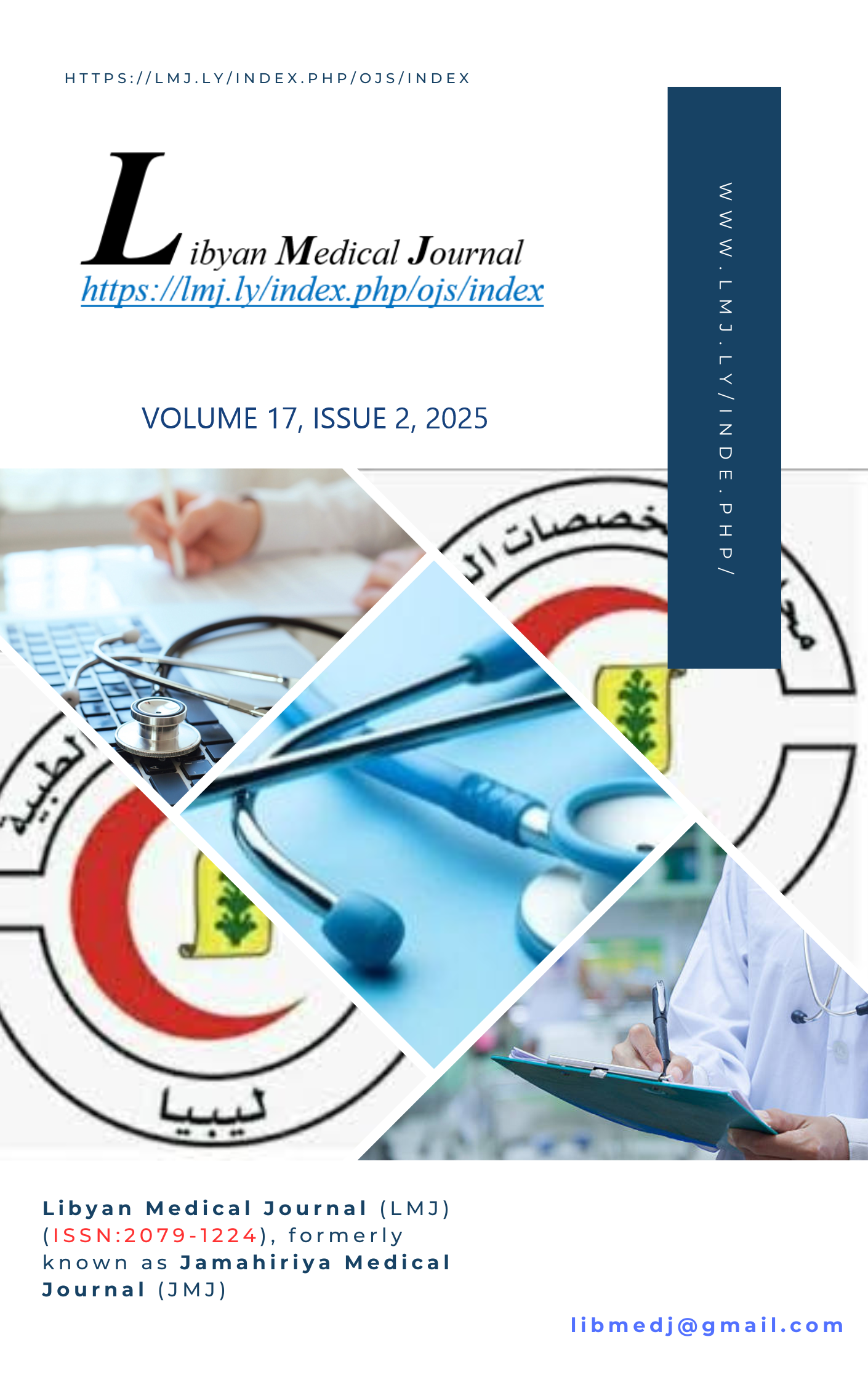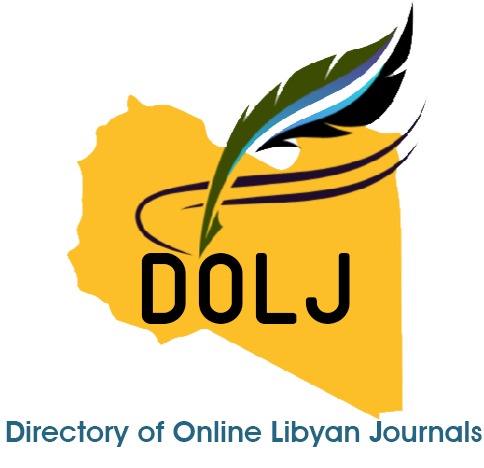Effect of the Whole-Body Vibration versus Treadmill Training on Liver Function in Obese Adults
DOI:
https://doi.org/10.69667/lmj.2517220Keywords:
Whole Body Vibration, Treadmill Training, Liver Function, Obese AdultsAbstract
There is a lack of awareness of the efficacy of whole-body vibration and treadmill training on liver function in obese adults in Libya. The study aimed to show the difference in the whole-body vibration and treadmill training on liver function in obese adults. Forty obese adults of both genders (21 women and 19 men) were enrolled in this study; they were recruited from the relatives of the patients in Libya. Their age ranged from 35 - 45 years with body mass index (BMI) between 30-34.9 kg/m2 (Class I obesity), the waist/hip ratio less than one, and they were assigned randomly into two equal-sized groups of equal number (A and B). Group (A) includes 20 obese adults who received diet advices (to prevent increasing weight) and treadmill training while group (B) received includes 20 obese adults who received the same diet advices of group (A) and whole-body vibration exercises (vibration frequency was set to 30 Hz then increased gradually to 35 Hz, then the subject took about 20 minutes to fulfill a training session). The participating subjects in this study were assessed by liver enzyme tests and anthropometric measurements. They were evaluated before and after the treatment program, about three sessions per week for eight weeks. The obtained results revealed significant differences in all measured variables before and after treatment in the two groups. Statistically significant difference was also found in post-treatment values of all measured variables when compared between the two groups in favor of group (A). Treadmill training and whole-body vibration exercise can be added to the physical therapy program.
References
World Health Organization (WHO). Obesity and Overweight. 2021; Available online: https://www.who.int/news-room/fact-sheets/detail/obesity-and-overweight (accessed on 20 June 2021).
Deal BJ, Huffman MD, Binns H, Stone NJ. Perspective: Childhood obesity requires new strategies for prevention. Adv. Nutr. 2020; 11 (5): 1071 - 1078.
Alnajar MA. Junk Food Consumption and its Health Effect among Medical Students in Baghdad, Iraq. Attahadi Medical Journal. 2024 Jul 12:28-34.
Cardinale M, Leiper J, Erskine J, Milroy M, Bell S. The acute effects of different whole body vibration amplitudes on the endocrine system of young healthy men: a preliminary study. Clin. Physiol. Funct. Imaging 2016; 26 (6): 380 - 384.
Milanese C, Piscitelli F, Zenti MG, Moghetti P, Sandri M, Zancanaro C. Ten-week whole-body vibration training improves body composition and muscle strength in obese women. Int. J. Med. Sci. 2013; 10 (3): 307 - 311.
Park SY, Son WM, Kwon OS. Effects of whole body vibration training on body composition, skeletal muscle strength, and cardiovascular health. J. of Exerc. Rehab. 2015; 11 (6): 289 - 295.
Hamada M, Khater S, Behairy A, Behairy R, Arisha A, Shalaby S. Effect of Moderate Treadmill Exercise on Hepatic Lipid Metabolism in Rats. Zaga. Veter. J. 2020; 48 (2): 165 - 173.
Patel H, Alkhawam H, Madanieh R, Shah N, Kosmas CE, Vittorio TJ. Aerobic vs anaerobic exercise training effects on the cardiovascular system. World J. Cardiol. 2017; 9 (2): 134 - 138.
Bidonde J, Busch AJ, Schachter C, Overend TJ, Kim SY, Goes SM, Boden C, Foulds HJ. Aerobic exercise training for adults with fibromyalgia. Cochrane Database Syst. Rev. 2017; 6 (6): 12 - 17.
Das AK, Chandra P, Gupta A, Ahmad N. Obesity and the levels of liver enzymes (ALT, AST & GGT) in East Medinipur, India. Asi. J. Med. Sci. 2014; 6 (1): 40 - 42.
Casadei K, Kiel J. Anthropometric Measurement). In: StatPearls [Internet]. Treasure Island (FL): StatPearls Publishing; Jan 2021.
Raatz SK, Wimmer JK, Kwong CA, SD. Intensive diet instruction by registered dietitians improves weight-loss success. J. Am. Diet Assoc. 2008; 108 (1): 110 - 113.
Ibrahim AA, Abdelbasset WK. The role of physical exercise in treating people with nonalcoholic fatty liver disease". J. of Adv. Phar. Educ. & Res. 2020; 10 (2): 64 - 70.
Muir SW, Berg K, Chesworth B., Speechley M. Use of the Berg balance scale for predicting multiple falls in community-dwelling elderly people: a prospective study. Phys. Ther. 2018; 88 (4): 449 - 459.
Klaus B, Tim V, Jurgen S. Efficiency of vibration exercise for glycemic control in type 2 diabetes patients. Int. J. Med. Sci. 2007; 4 (3): 159 - 163.
Pedersen BK, Saltin B. Exercise as medicine-Evidence for prescribing exercise as therapy in 26 different chronic diseases. Scand. J. Med. Sci. Sports 2015; 25 (3): 1 - 72.
Slater GJ, Dieter BP, Marsh DJ, Helms ER, Shaw G, Iraki J. Is an Energy Surplus Required to Maximize Skeletal Muscle Hypertrophy Associated with Resistance Training. Front. Nutr. 2019; 6 (1): 131 - 134.
Luan X, Tian X, Zhang H, Huang R, Li N, Chen P, Wang R. Exercise as a prescription for patients with various diseases". J. Sport Health Sci. 2019): "; 8 (5): 422 - 441.
Hallsworth K, Fattakhova G, Hollingsworth KG, Thoma C, Moore S, Taylor R, Day CP, Trenell MI. Resistance exercise reduces liver fat and its mediators in non-alcoholic fatty liver disease independent of weight loss. Gut. 2011; 60 (9): 1278 - 1283.
Schwingshackl L, Dias S, Strasser B, Hoffmann G. Impact of different training modalities on anthropometric and metabolic characteristics in over-weight/obese subjects: A systematic review and network meta-analysis. Plos. One. 2013; 8 (12): 53 - 62.
Angulo P. Nonalcoholic fatty liver disease. Rev. Gastroenterol. Mex. 2012; 2 (75): 196 - 200.
Wong S. A primary care approach to non-alcoholic fatty liver disease. Singa. Family Phys. 2014; l35 (4): 44 - 47.
Croniger C. An unbiased approach to discover novel therapies for liver disease. J. Metabon. Metabol. 2012; 1 (1): 1 - 2.
Liu Y, Zhai M, Guo F, Shi T, Liu J, Wang X, Zhang X, Jing D, Hai C. Whole body vibration improves insulin resistance in db/db mice: amelioration of lipid accumulation and oxidative stress. Appl. Biochem. Biotechnol. 2016; 179 (5): 819 - 829.
McGee-Lawrence ME, Wenger KH, Misra S, Davis CL, Pollock NK, Elsalanty M, Ding K, Isales CM, Hamrick MW, Wosiski-Kuhn M, Arounleut P, Mattson MP, Cutler RG, Yu JC, Stranahan AM. Whole-Body Vibration Mimics the Metabolic Effects of Exercise in Male Leptin Receptor-Deficient Mice. Endocrinology 2017; 158 (5): 1160 - 1171.
Wilms B, Frick J, Ernst B, Mueller R, Wirth B, Schultes B, Whole body vibration added to endurance training in obese women - a pilot study. Int. J. Sports Med. 2012; 33 (9): 740 - 743.
Cochrane DJ. Is vibration exercise a useful addition to a weight management program?. Scand J. Med. Sci. Sports. 2012; 22 (6): 705 - 771.
Novotny SA, Mader TL, Greising AG, Lin AS, Guldberg RE, Warren GL, Lowe DA. Low intensity, high frequency vibration training to improve musculoskeletal function in a mouse model of duchenne muscular dystrophy. PLoS One 2014; 9 (8): 104 - 139.
Oh S, Oshida N, Someya N, Maruyama T, Isobe T, Okamoto Y, Kim T, Kim B, Shoda J. Whole-body vibration for patients with nonalcoholic fatty liver disease: a 6-month prospective study. Physiol. Rep. 2019; 7 (9): 1 - 13.
Oh S, Shida T, Sawai A, Maruyama T, Eguchi K, Isobe T, Okamoto Y, Someya N, Tanaka K, Arai E, Tozawa A, Shoda J. Acceleration training for managing nonalcoholic fatty liver disease: A pilot study. Ther. Clin. Risk Manag. 2014; 10 (1): 925 - 936.
Belloa A, Sallì M, Lombardo M, DAdamo M, Guglielmi V, Tirabasso C, Giordani L, Federici M, Lauro D, Foti C, Sbraccia P. Effects of whole body vibration plus diet on insulin-resistance in middle-aged obese subjects. Int. J. Sports Med. 2014; 35 (6): 511 - 516.
Bhat G, Baba C, Pandey A, Kumari N, Choudhuri G. Life style modification improves insulin resistance and liver histology in patients with non-alcoholic fatty liver disease. World J. Hepatol. 2012; 4 (7): 209 - 217.
Udristioiou A., Cojocaru M. From the meta-bolic syndrome to a normal status. Euro. J. of Bio-tech. Bioscie. 2013; 1 (2): 50 - 54.











